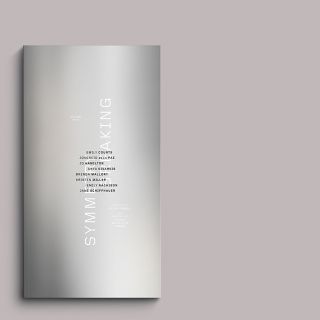And from this distance…
Works
- 2016
- Books / editorial
- Art Gym
- And from this distance, one might never imagine that it is alive
Companion volume for an eclectic 2016 survey of Northwest abstractionists, curated by Blake Shell for the Art Gym. The show took its title from a soliloquy delivered by Special Agent Dana Scully in an episode of The X-Files, which is in itself a fairly abstract start. The artists ranged in age from their twenties through their sixties; the elements they had in common were the nonobjective nature of their work and their geographic location in the Northwest.
As part of the brief, the curator requested that we collaborate with the critic Graham Bell on a bubble map showing each artist arranged according to their origin and connected to various influences, art-historical moments, and so on. The result was completely subjective and crazy, a parody of data visualization. But it also provided some insight, revealed some hidden resonances among the artists, and helped structure the book.
Besides the two essays, which were illustrated in-line (that is, with each image rendered as close as possible to its reference in the text), each artist was allotted six pages in which their work was presented in relative scale, along with a divider page containing a brief biography and a statement, color-keyed back to the map. Colors were derived from the hues common to each artist’s work.
Illustrations
1.
Cover

The exterior of the book is executed entirely in matte white type and gloss clear foils on 4-ply gray binder’s board, which is then laminated to the front and back covers of the book block. This is partly a punt (how do you represent a broad survey with the work of just one artist?), and partly an effort to push a sense of materiality: as abstract painting tends to be about the medium itself, we decided to lead with the materials of the object up front.
2.
Frontispiece

Large detail of Grant Hottle’s painting Marsyas (2015), cropped so tightly as to strip it of any possible context, leaving the reader with only color and surface.
3.
Contents

At transition points, the book shows large fields of flat color derived from the illustrated works themselves; here, on the table of contents, a yellow-orange from Jack Featherly’s Fax Generation (2015) . . .
4.
Essay opening

. . . and here a pale blue from Featherly’s Unpattern #2 (2015). Display typography is large but recedes into the ground, with only the type sitting on top. There’s a fat-over-lean visual metaphor going on here, though we may be the only ones who see it.
5.
Essay interior

Text is arranged asymmetrically with a generous left margin for illustrations, which are placed as close as possible to their references within the essay.
6.
Map of the territory

At the turn between the first essay and the individual artist pages is a gatefold containing a visual representation of the artists’ origins and influences organized along several axes: in the upper half, the artists—all now Northwest residents—are distributed from west to east according to the time zones in which they were born . . .
7.
Map, opened

. . . and along the bottom are the names of various arts movements and media and related practitioners. Each artist was assigned a color—subjectively drawn from their work—which keyed their subsequent appearance in the text.
8.
Artist section opening

Apart from contextual appearances within the book’s two essays, each artist is allotted six pages, a biography, and a statement. Works are shown in relative scale within the artist’s section . . .
9.
Artist section interior

. . . and positioned within the pages to give each work appropriate white space. Caption information is assigned to a horizontal axis along the book’s lower third.
Colophon
96pp + cover
8 × 11 in., ed. 500
4c digital on matte coated paper (text); white and clear foil on 4-ply binder’s board (cover)
Composed in ATF Garamond and Founders Grotesk
- Essays
- Graham Bell
Sue Taylor - Editor
- Allison Dubinsky
- Photography
- Jonathan Bagby
T. Harrison
Dan Kvitka
Evan La Londe
Christine Taylor
Worksighted - Printing
- Brown Printing


